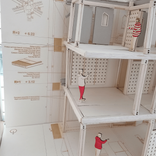Presentation
“Thanks to their training in the visual arts and technical skills, interior architects are able to design, restructure, rehabilitate and transform a wide variety of spaces: from individual spaces, such as private houses and flats, to collective, institutional, industrial, tertiary, commercial, sports, hotel, hospital and even museum spaces. Their aim is to improve the overall functioning of the building or site by adapting it to a precise and rigorous program presented by a public or private client.” (CFAI)
Architecture intérieure (FULL FRENCH)
Proposer une vision globale
Fiche technique
5 ans
Initial
Bac+5
Niveau Bac, VAE
Lyon, Bordeaux
Architecte intérieur Certifié Niv.7
The course
ESAIL offers a five-year Interior Architecture course which can be accessed after obtaining a baccalaureat (or equivalent) or via a recognition of prior learning and experience scheme. This course will allow you to grasp all the technical and graphic components of the profession.
The Interior Architecture course will equip you to be able to design, lay out or rethink different types of structures: apartments, houses, office spaces, stores etc. You will learn to manage a project from A-to-Z, calling on the full range of artistic and technical skills acquired throughout your Interior Architecture studies and through the numerous internships undertaken during the course.
The profession :

The profession :
Interior architects work mainly on the renovation of old buildings. The aim is to adapt this heritage to the needs of today's society while respecting it.
In their design work, interior architects have to ensure that contemporary interior spaces coexist with an old architectural envelope. They work on buildings that may have remained fixed to the period in which they were built, while society itself is constantly evolving.
Recent examples include the arrival of remote working, which has changed the way we use our homes and office spaces. In the home, multi-functionality and modularity of interior spaces have become themes for reflection. On another level, a greater awareness of ecological issues can influence the choice of building materials by directing the design process towards short supply chains. More generally, the well-being of the occupants of a building has become an increasingly important consideration in our society over the years.

In this professional context, the interior architect contributes to the recycling of old buildings and is totally in tune with the current challenges facing our society, which is seeking to reduce its impact on the environment. Adapting old buildings does not lead to land artificialization, and greatly reduces the need for materials and energy.
Interior design professionals are faced with the challenge of renovating old structures, seeking to adapt them to new lifestyles while respecting heritage features. These old buildings, enriched by a new interior architecture, find a new use and sometimes a new role within the multiple human activities.
Skills

Skills
An Interior Architect is a professional working with spaces. They play with volumes, light, materials and colour to provide solutions even for the most demanding projects.
As each project is unique, it is vital that the Interior Architect knows how to listen to their clients with the aim of understanding their needs and expectations, whilst paying particular attention to their personality. Interior Architects also need to follow the latest trends in furniture and fittings to be able to make suggestions to their clients.
As Interior Architects are required to meet the needs of their clients and respond to the technical constraints of the interior spaces they work on, this profession requires a sound knowledge of buildings and the materials they will work with.
FAQ: Everything you need to know about the Interior Architecture course
How to become an Interior Architect?
In order to become an Interior Architect, you can take a five-year Interior Architecture course to gain an understanding of all aspects of the profession: technical, graphic, conceptual and cultural. This course is particularly well-suited to people interested in changing careers to become an Interior Architect.
What does an Interior Architect do?
An Interior Architect designs and builds innovative interior spaces. The profession is broad and highly diversified in terms of the skillset required.
What are the personal qualities required to become an Interior Architect?
An Interior Architect must be versatile. They need to be creative, methodical, open in their interactions with their clients, inquisitive, technical and with a wealth of cultural references.
Testimony:

Timeline
Portfolio
The work presented is composed of partial extracts from the documents produced by students for their final exams. They show the skills acquired in interior design and interior architecture project design.
Bordeaux Campus
The Bordeaux campus is located in the Bassins à Flots district, a sector of the city that has benefited from a highly successful urban renovation project.
The campus covers a surface area of 2,000 m² and is home to seven schools. The campus is equipped with a range of facilities including:
Modular classrooms, IT rooms, a business incubator, cafeteria and leisure spaces.
Lyon Campus
Originally located in the former military buildings at the Fort de Vaise (Lyon 9), the school has continued to develop to become one of the leading Interior Architecture schools in France. The Lyon campus is located in the Gorge de Loup area which is undergoing major development and offers excellent public transport links. The Lyon campus is spread across two buildings with a total surface area of 22,000m², housing 23 higher education establishments. The campus offers a full range of shared services and facilities including:
Modular rooms, an IT room, a model room, a learning resource centre, a large lecture hall, a business incubator, cafeteria and leisure spaces, with options for doing sport.